Thanks to the website ScottishGeology.com, run by Angus Miller, I learned of Barns Ness, a Mississippian-aged limestone fossil site on the shore not far from where we are staying at Dunbar. We ventured out there on Saturday afternoon, in search of fossils.
The presence of the Dunbar Cemenet Works nearby is an indication that this is the most extensive limestone outcrop in central Scotland.
I set my field assistant loose on the beachy outcrops to find fossils:

The first one we spotted was a familiar sight from the shales back home – Zoophycos, a feeding trace fossil:

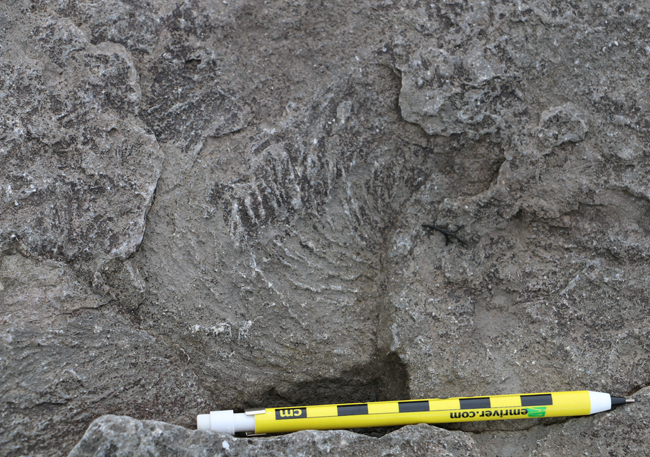
Then, as we worked our way down-section, the crinoids started showing up:
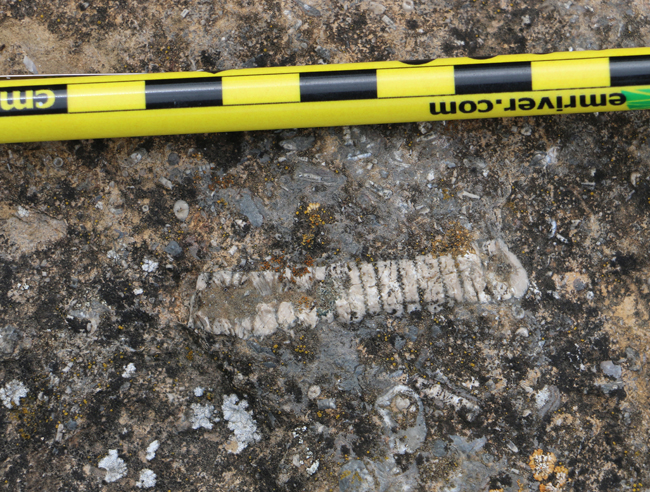
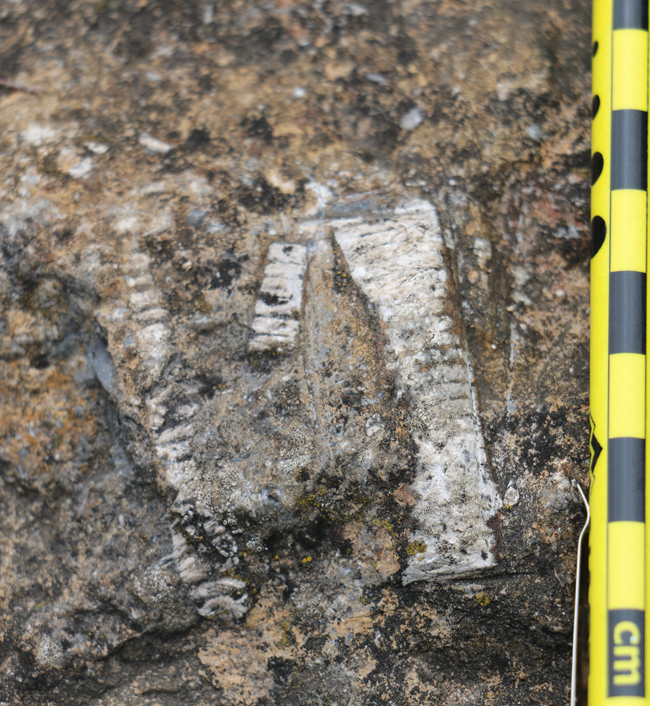

Other, meatier traces also appeared:



We spied a few large cross-sectioned shells – though I’m not sure quite what they would be. Maybe massive brachiopods?
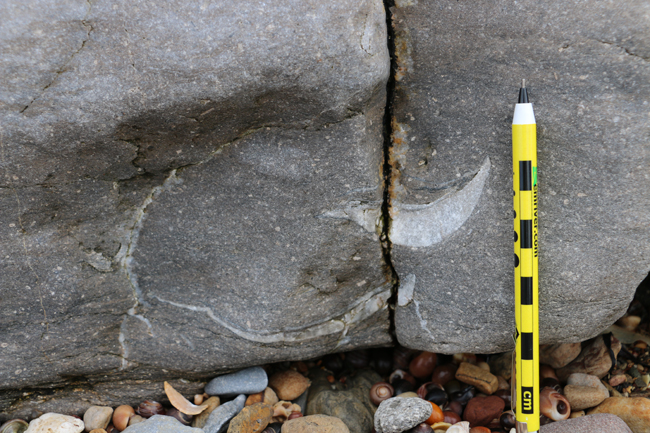
Also, there were corals. Very nice corals.
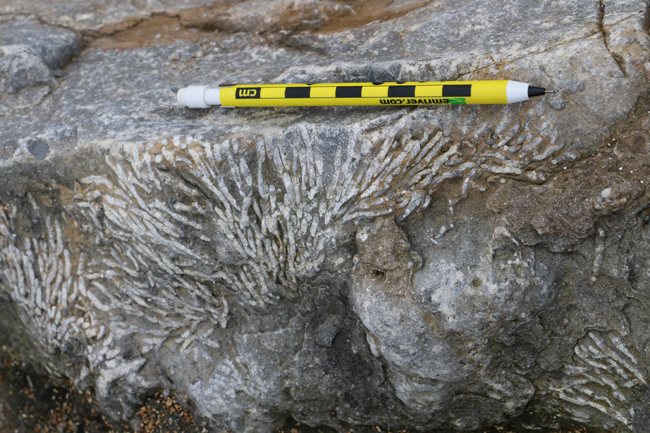
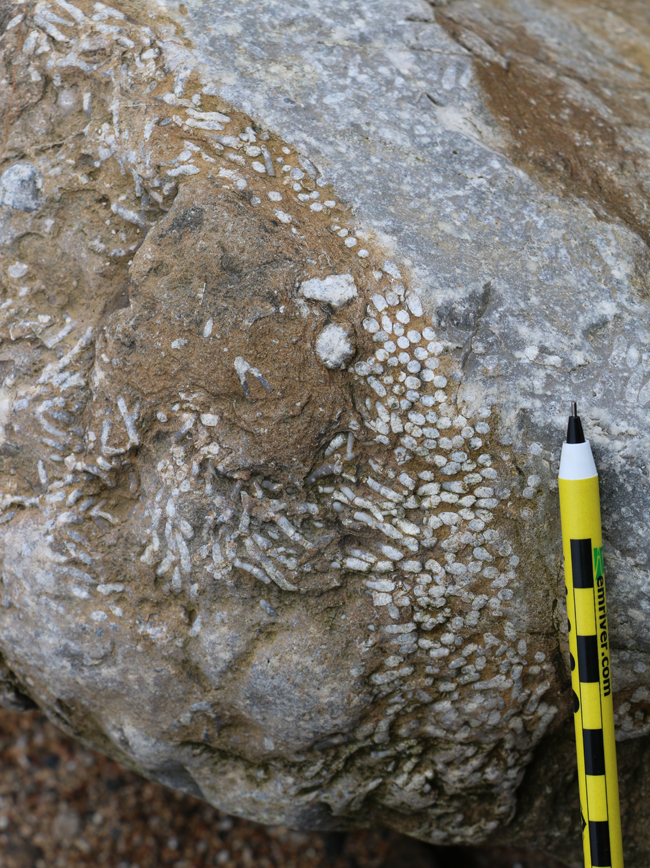
A few more examples:


Finally, we found what, for me, was the object of the trip – the “Dunbar Marble,” a limestone (not a marble) that was quarried as a building stone (in particular, for fireplaces) because of its lovely super-rich content of rugose corals, which are the white bits shaped like little cornucopias:

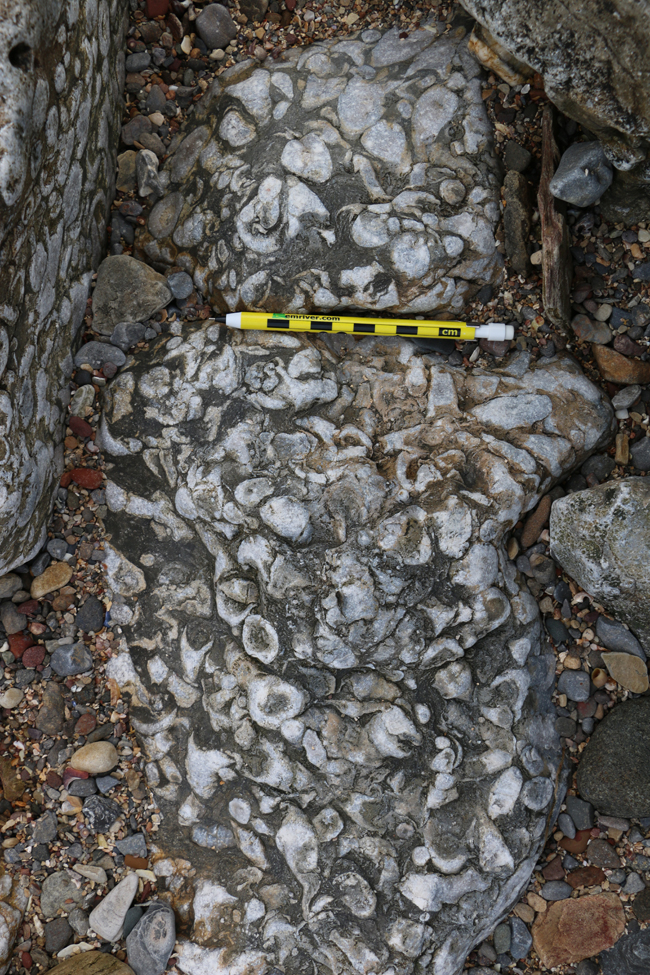

Here is the cleanest, clearest face I could find showing a cross-section of this extraordinary bed:
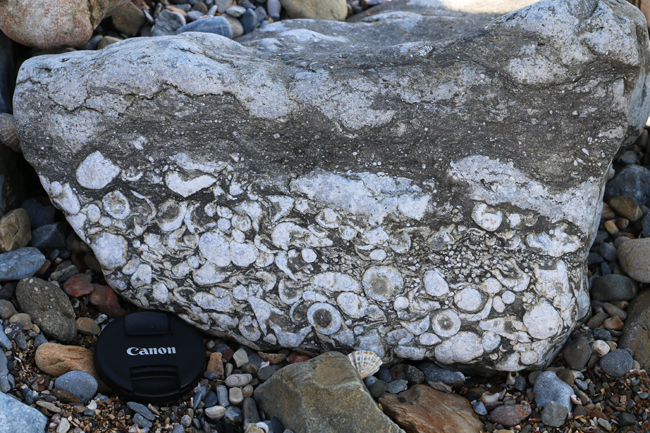
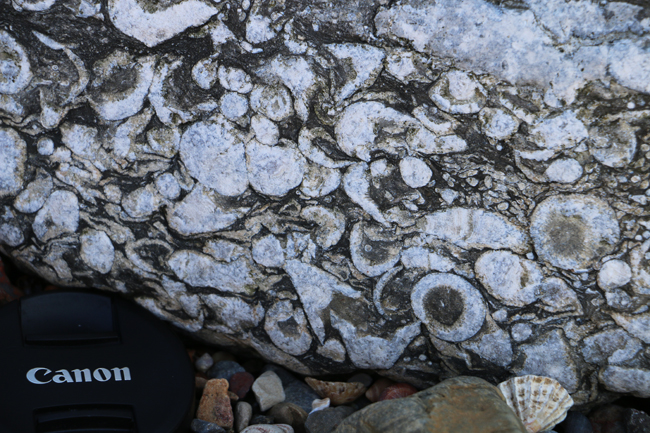
All of the preceding examples of the “Dunbar Marble” have been battered a bit – exposed more through the action of physical weathering (think regular poundings by pebbles and beach sand) than chemical weathering (slow dissolution of the carbonate, a bit faster in some spots and a bit slower in other spots). But this example that my wife found bucks that trend. Click on it to see the fine details of the segmentation and septae in the corals. Bonus: there’s a modern limpet shell to examine, too:
Here are three GigaPans of the outcrop, which as you can see is half buried in beach sediment, if you want to explore them a bit:
Link GigaPan by Callan Bentley
Link GigaPan by Callan Bentley
Link GigaPan by Callan Bentley
While the GigaPans were shooting, I went for a stroll across the tidal flats. Heading for a prominent outcrop in the middle distance, I hopscotched my way accross a lumpy surface that looked stromatolitic:
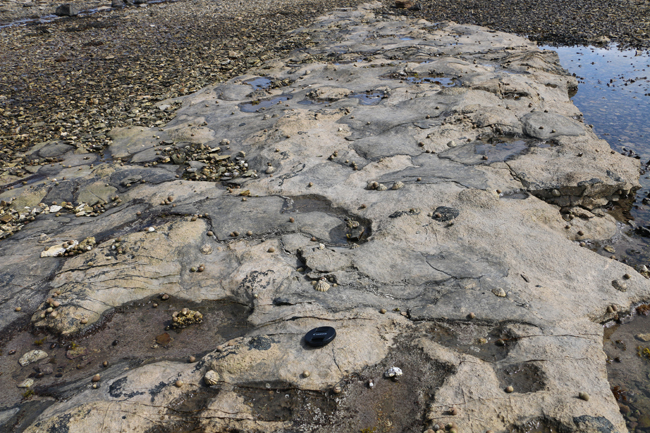
I couldn’t detect any convex laminations on that surface, but since the tide was coming in, I also didn’t spend much time on the task. Another possibility is that these lumps and hollows represent original features in the bedding – perhaps they are associated with tree roots, according to the pamphlet linked to above. However, I did spy a boulder that had some dome-ish looking internal layering:

If I’m right that these are stromatolites, then the sample is “upside down” in these photos – the dome would bulge upward toward the sun in life position. Stromatolites are thus geopetal (“way-up”) indicators.
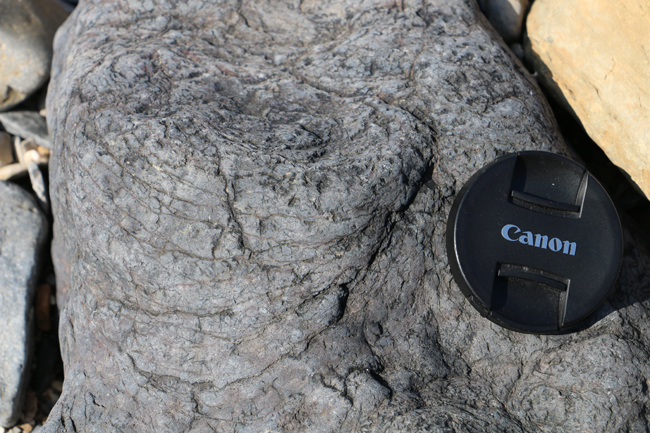
Elsewhere, I found very crinkly little CaCO3 features, which didn’t quite appear regular enough to qualify as stromatolites, but I wasn’t really sure what else to classify them as. They didn’t appear to have any kind of regular anatomy like I would expect from an invertebrate animal:


On a few of those, I see a shape and internal anatomy that suggests articulate brachiopods, as well as slightly-lighter colored internal sediment, suggesting a hollow chamber. But elsewhere (like the lowermost left), it looks like a layered repetitive crinkly mass.
I guess it could be more than one type of fossil. Anyhow: the tide’s coming in! Keep moving!
I arrived at my target outcrop, expecting it to be the weathering face of a tough bed, but instead I found a wall-like tabular projection. It’s a fault – weathering out in positive relief!

The fact that the fault weathers out in as a “wall” is plain if you look at Barns Ness from the perspective of Google Maps. It’s the feature that strikes northeast-southwest across the middle part of this view. Zoom in and you can see it casting its shadow:
Close-up, it shows lots of brecciation:
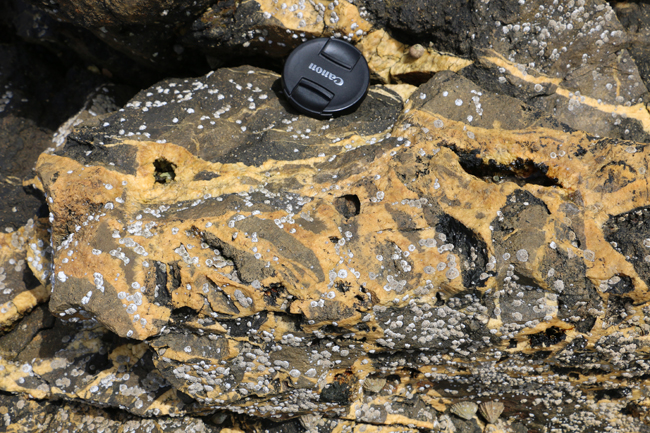
Fluids percolating along the fault cemented these fragments back together, and indurated the fault trace, making it more resistant to weathering than the neighboring host rock.

The rising tide cut off my retreat along the path I had just trod, so I headed inland, and found that beneath the fossiliferous strata was a recessively-weathering shale (aren’t they all?) and at its base a thin coal seam:
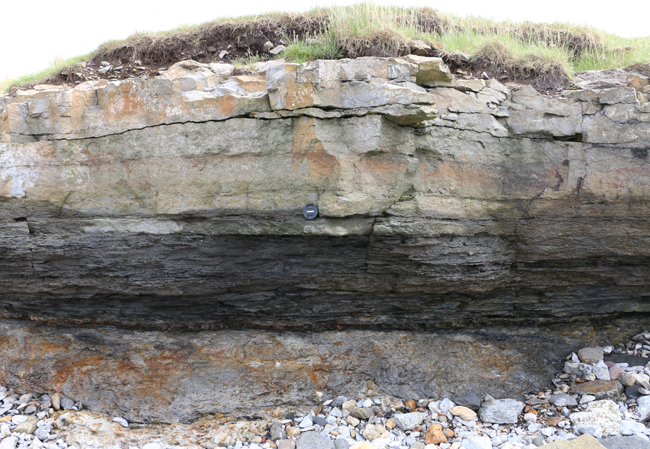

This site, then, is a nice exemplar of the many small transgressions of sea level during the Carboniferous that buried coastal swamps (bayous) under offshore marine sediments, condemning the plants to become coal. Groundwater flow seems to percolate through the limestone and sandstone well enough, but finds the shale an aquitard, resulting in some small effusive springs above the beach:

All told, Barns Ness had much to hold the geologist’s interest – and I’d spend more time here if I had it.


I’ve been enjoying your trip photos and I love that you are sharing the fun with your budding geologist. I thought Ohio’s Ordovician/Silurian limestones were chock-full of fossils – those are great pics and a great diversity! Thanks for sharing.
Wow, those great photo’s make my Mississippian heart go pitter-patter. Really, interesting to see a more open-marine facies than what I used to see in the Valley and Ridge Upper Mississippian limestones.
The branching coral is probably Syringopora (or a closely related genus) (Here is a Virginia/West Virginia example: https://www.flickr.com/photos/79475348@N03/14012502204/in/album-72157644301124792/) .
I agree on the stromatolites – maybe more like thrombolites. I never saw anything quite like that in the Virginia Mississippian.
Some of those odd shapes are definitely brachiopods (in one specimen, you can see the hinges), Maybe there are a bunch of stacked-up thin-shelled brachiopods at the base of a storm bed? Other structures there are head-scratchers for me. No doubt, someone will know what’s there.
Regardless, a great site. Even with Yoredale-like cycles.
Great stuff. Very useful, as I am going there with a geology excursion this Monday. One question completely unrelated to the geology. Where did you get that sweet mechanical pencil with scale bar? I would love to get one.